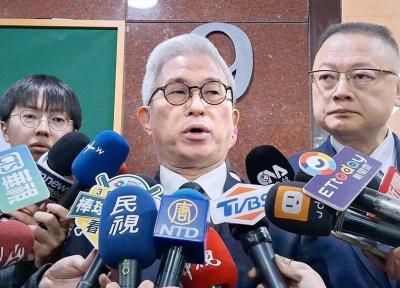The presence of Chinese National Institute for South China Sea Studies president Wu Shicun (吳士存) at the Exhibition on the Republic of China’s (ROC) Historical Data for the Southern Territories early this week has drawn concern among Taiwanese academics, who said it might have given Beijing the opportunity to gather information that it can use to justify its claims of sovereignty in the South China Sea when it presents its case before the International Court of Justice in The Hague, Netherlands, later this year.
China has been involved in a series of sovereignty conflicts over islands in the South China Sea, notably with Vietnam and the Philippines. Manila has responded by filing a complaint with the International Court for Arbitration, providing the court with more than 4,000 pages of evidence and analyses to counter Beijing’s claims.
Taiwan also lays claim to some of the islands, including the Pratas Islands (Dongsha Islands, 東沙群島) and the Itu Aba Island (Taiping Island, 太平島), the largest island in the Spratly Islands.
Explaining Taiwan’s claim, Taiwan Society of International Law deputy secretary-general Lin Ting-hui (林廷輝) said that the international community has long expressed an interest in how the “U-shaped” theory came into being.
The “U-shaped” theory refers to the ROC’s formal claim of sovereign territory in the South China Sea post-World War II, in accordance with agreements made in the Cairo Declaration of Nov. 27, 1943, and the Potsdam Declaration of July 26, 1945.
Several US thinktanks have urged Taiwan — ie, the ROC — to publish studies and proofs on how the lines were established and what their status in terms of international law are, Lin said.
While China holds data dating from the Ming and Qing dynasties, it lacks data from the period when the ROC was in control of China, Lin said.
These data are what support Taiwan’s claims in the South China Sea, and they should not be used to back up Chinese claims in the area, Lin said.
If the Chinese were able to gain any information from the exhibit to help defend their stance in December, it would work greatly to their benefit, Lin said.
Lin said he was puzzled why Vietnam and the Philippines did not send representatives when the exhibit opened on Monday, adding that all three countries should have sent representatives, or none at all.
Wu should not have been the only one to show up at the exhibit, Lin said.
He added that Taiwan should avoid the “one China” framework and avoid citing the “U-shaped” theory any more as it would give historical credence to China, as Beijing is viewed as the sole legal representative of China in the international community following UN Resolution 2758.
Taiwan should exert its sovereignty claim over the Pratas Islands and Itu Aba Island, Lin said, adding that the territories fall under the jurisdiction of Greater Kaohsiung.
Only then can Taiwan further its claims in accordance with International Maritime Law and avoid the “one China” framework, Lin said.
Wu arrived in Taiwan on Saturday last week, leading a delegation of researchers attending a closed-door conference on recent developments in the South China Sea and its impact on regional security and cross-strait relations.
The conference was hosted by National Chengchi University and National Taiwan Normal University.

Taiwan is to commence mass production of the Tien Kung (天弓, “Sky Bow”) III, IV and V missiles by the second quarter of this year if the legislature approves the government’s NT$1.25 trillion (US$39.78 billion) special defense budget, an official said yesterday. Commenting on condition of anonymity, a defense official with knowledge of the matter said that the advanced systems are expected to provide crucial capabilities against ballistic and cruise missiles for the proposed “T-Dome,” an advanced, multi-layered air defense network. The Tien Kung III is an air defense missile with a maximum interception altitude of 35km. The Tien Kung IV and V

The disruption of 941 flights in and out of Taiwan due to China’s large-scale military exercises was no accident, but rather the result of a “quasi-blockade” used to simulate creating the air and sea routes needed for an amphibious landing, a military expert said. The disruptions occurred on Tuesday and lasted about 10 hours as China conducted live-fire drills in the Taiwan Strait. The Civil Aviation Administration (CAA) said the exercises affected 857 international flights and 84 domestic flights, affecting more than 100,000 travelers. Su Tzu-yun (蘇紫雲), a research fellow at the government-sponsored Institute for National Defense and Security Research, said the air

A strong continental cold air mass is to bring pollutants to Taiwan from tomorrow, the Ministry of Environment said today, as it issued an “orange” air quality alert for most of the country. All of Taiwan except for Hualien and Taitung counties is to be under an “orange” air quality alert tomorrow, indicating air quality that is unhealthy for sensitive groups. In China, areas from Shandong to Shanghai have been enveloped in haze since Saturday, the ministry said in a news release. Yesterday, hourly concentrations of PM2.5 in these areas ranged from 65 to 160 micrograms per cubic meter (mg/m³), and pollutants were

Taiwan’s armed forces have established response protocols for a wide range of sudden contingencies, including the “Wan Chun Plan” to protect the head of state, the Ministry of Defense (MND) said today. After US President Donald Trump on Saturday launched a series of airstrikes in Venezuela and kidnapped Venezuelan President Nicolas Maduro, concerns have been raised as to whether China would launch a similar “decapitation strike” on Taiwan. The armed forces regularly coordinate with relevant agencies and practice drills to ensure preparedness for a wide range of scenarios, Vice Minister of National Defense Hsu Szu-chien (徐斯儉) told reporters before a